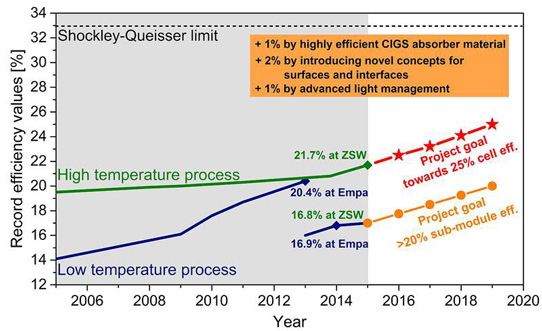- News
2 June 2015
Sharc25 EU-funded project targets 25% efficiency from CIGS PV
Launched in May and due to last three and a half year, the new European research project Sharc25 ('super high efficiency Cu(In, Ga)Se2 thin-film solar cells approaching 25%') aims to increase the solar energy conversion efficiency of thin-film solar cells (made by the coevaporation of copper indium gallium (di)selenide) from the existing record of 21.7% to 25%.
The project has received €4.6m in funding from the European Union via Horizon 2020 (the EU's framework program for Research and Innovation for 2014-2020) under grant agreement 641004. The Swiss government is providing a further €1.6m.
To develop the improved cells, the project will pool the multi-disciplinary skills of 11 research partners in eight countries. Coordinated by ZSW (Zentrum für Sonnenenergie- und Wasserstoff-Forschung — or Center for Solar Energy and Hydrogen Research — Baden-Württemberg) of Stuttgart, Germany, the other partners are the EMPA (Swiss Federal Laboratories for Materials Science and Technology), the universities of Luxembourg, Rouen (in France), Parma (in Italy) and Aalto (in Finland), nanoelectronics R&D center IMEC (in Belgium), the HZB (Helmholtz-Zentrum Berlin für Materialien und Energie in Germany), the International Iberian Nanotechnology Laboratory INL (in Portugal), Flisom AG (in Switzerland), and Manz CIGS Technology GmbH (in Germany).

Picture: Goals of the Sharc25 project.
In recent years, the performance of thin-film solar cells based on chalcopyrite material has improved markedly. Able to achieve 20.4% efficiency, CIGS solar cells on plastic foil are almost on a par with multi-crystalline solar cells. CIGS cells on glass exceeded that for the first time in 2013 and increased their lead by 1.3 percentage points to 21.7% in 2014. These two records were achieved by two partners in the Sharc25 project: EMPA holds the record for the foil substrate and ZSW for glass.
The five research institutes, four universities and two companies involved in Sharc25 are pursuing three strategies to harness the power of new designs for more efficient surfaces and interfaces, and to optimize light management to raise the efficiency threshold further, targeting an increase of about three percentage points in efficiency to 25%.
An improvement on this scale would challenge the dominance of multi-crystalline solar cells from Asia, and the newfound competitive edge could give the European thin-film PV industry a decisive boost, reckons ZSW. The project's mission also calls for the researchers to devise a strategy for translating research results into industrial applications.
If the solar industry succeeds in applying the technology, the cost of manufacturing solar modules in Europe could drop below 35 Eurocents per watt peak and the cost of installed PV systems to below 60 Eurocents per watt peak, it is reckoned. Further savings could be achieved by ramping up the new technology for mass production. This would drive down investment costs, for example, to less than 75 Eurocents per watt peak for solar CIGS module factories with more than 100MW manufacturing capacity, it is estimated.
ZSW raises thin-film PV efficiency record from 21% to 21.7%
Empa raises efficiency record for flexible CIGS thin-film solar cells from 18.7% to 20.4%


